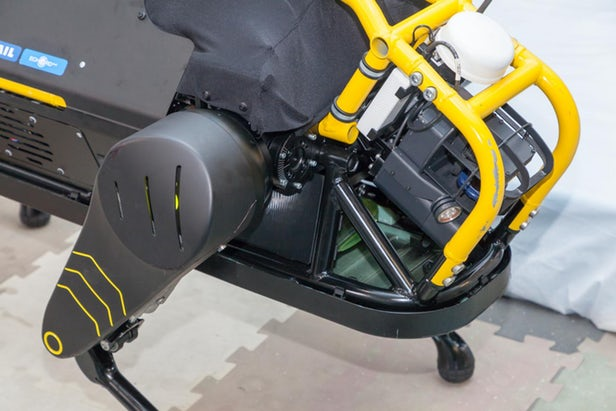Last time we wrote about the HyQ robot, it had just mastered walking and begun venturing into rough terrain. Now, its successor has done so with a three-ton passenger airplane in tow. Granted seven years of research and development have played out since, it is an impressive show of strength for a hydraulically actuated robot not much bigger than a dog.
In its current form, HyQReal is 133 cm long and 90 cm tall (4.3 x 3 ft), while its total weight comes to 130 kg (287 lb). In the engine room is a 48-V battery that powers four electric motors, which hook up to four hydraulic pumps to make the robot move. A pair of computers, meanwhile, help the HyQReal navigate its surroundings. All of this is wrapped up in an aluminum roll cage and skin made from a mix of Kevlar, glass and plastic.
The robot was developed by scientists at the IIT-Istituto Italiano di Tecnologia, who recently pushed its capabilities to the limit at Italy’s Genoa Airport. The team hooked up HyQReal to a Piaggio P180 Avanti, a small passenger plane with a length of 14.4 m, wingspan of 14 m (47 and 45 ft) and a hefty weight of 3,300 kg (7,275 lb).
Using its rubber feet, the robot does appear to struggle at first, but is able to put one foot after the other, slowly dragging the airplane down the runway over a relatively short distance. While this is an impressive spectacle, the overarching aim of this research project is to develop robots that can help out humans in disaster scenarios. You can imagine HyQReal using that towing capacity to pull huge pieces of rubble from collapsed buildings, for instance.
“Pulling a plane allowed us to demonstrate the robot’s strength, power-autonomy and the optimized design,” said Claudio Semini, project leader at IIT’s Dynamic Legged Systems lab. “We wanted to achieve something that has never been done before, and we succeeded…”
The team presented the robot’s impressive feat recently at the International Conference on Robotics and Automation, in Montreal. You can see the airplane-tow in the video below.
Source: IT-Istituto Italiano di Tecnologia via EurekAlert
(For the source of this article, and to watch the accompanying video, please visit: https://newatlas.com/hyqreal-robot-tows-plane/59837/)










